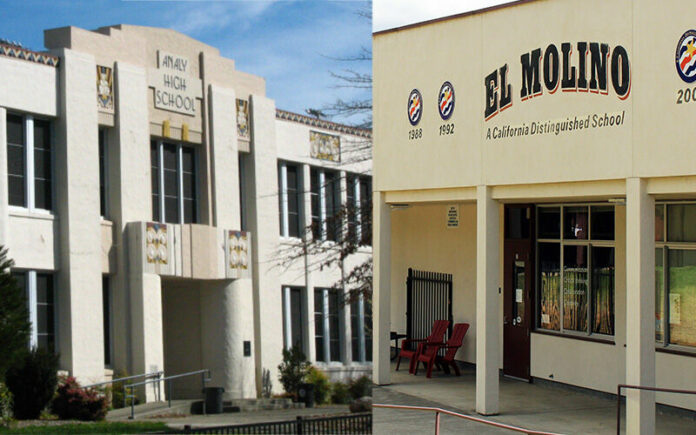Chief budget official warns structural deficit leaves few other options
Board members, parents and other community members buckled in for a nearly five-hour long town hall meeting to discuss the possibility of consolidating the West Sonoma County Union High School District (WSCUHSD) onto one campus.
Attendees at the Oct. 21 meeting voiced a fleet of questions and concerns, such as the consolidation’s impact on traffic, increased commutes for parents, hypothetical revenue to construction cost comparisons and the possibility that the campuses would need to expand again if declining enrollment reversed in coming years if families moved into the area.
Jennie Bruneman, director of facilities, maintenance and operations, clarified that the board would want to leave room for some growth because there were capacity issues at both the Analy and El Molino sites.
“But we also are a declining enrollment county, and the enrollment trends year on and year after are continually going down,” she said.
Steve Griffith asked whether the high school district’s feeder schools had been informed of the town hall and how the district could fund the consolidation models with its budget shortfalls. Superintendent Toni Beal said she sent information to the district superintendents, but that she could do more outreach.
Many questions sought more detail than the board could provide at its current stage since the trustees would not pursue deeper studies until they first decided whether to consolidate at all, according to Bruneman.
Sonoma County 5th District Supervisor Lynda Hopkins joined the call and agreed there was a lack of publicity around the town hall on a decision that would impact thousands of locals. She suggested more accessible ways to participate than requiring attendees to have a Zoom account and said the board should consider the vandalism, crime and fire risk of a vacant site.
Hopkins said as a Forestville resident, the thought of building a couple dozen rural residential homes in place of a campus that benefited families and the broader community felt like a crime. She also asked if the board could slow down its decision-making timeline.
“I feel like there’s just a lack of awareness in the community, and we’ve got a pandemic, we’re in the midst of election season, we’re in the midst of wildfire season,” she said, adding many west county residents recently evacuated and parents were extremely stressed managing distance-learning.
Breaking down the structural deficit
“This is really dictated by budget,” Beal said.
“Our district is at a place financially where consolidation may be one of the only things we can consider for us to remain solvent,” she said.
Beal said the WSCUHSD struggled with declining enrollment, program limitations and budget realities. She presented a graphic showing a steady decline from a little over 2,200 students in 2011 to around 1,800 in 2020.
“School districts across Sonoma County are declining,” she reminded attendees. “And yes, we do get interdistrict transfers, students outside our school district,” she said. But district Chief Business Official Jeff Ogston’s research showed those interdistrict transfers mostly came to west county in elementary school, joining Analy or El Molino from feeder schools like Oak Grove, Twin Hills or Gravenstein, Beal said.
Declining enrollment impacts the budget because the district’s funding comes from the size of its student population. Beal said the district is forced to cut programs because a shrinking student body makes it difficult to fund staffing and classes like Analy’s recently dropped culinary program or El Molino’s declining courses.
Combining schools would give the student body a critical mass that would allow for more variety of programs again, she said.
Numbers swirled around a presentation about the district’s structural deficit, and Ogston’s slides aimed to make some numbers make sense and ultimately conclude that some numbers did not.
“In simplistic terms,” he said, “structural deficit is where our expenses outweigh our revenues on an ongoing basis.”
Ogston continued, “School funding, or any funding, can have its challenges, and how the accounting works and how things end up on paper and what it looks like on paper is not always the true story. But at the end of the day, our expenses and the revenues that we know that we can count on, the revenues are not enough to cover our current expenses or projected ones.”
He said the schools historically relied on one-time funds, such as state funds or federal relief for the pandemic and surplus to cover the deficit.
The main recent increases in expenses exacerbating the deficit are non-public school (NPS) and SCOE services costs, transportation, property and liability insurance, salary increases and district contributions to the state teacher’s retirement system and public employees retirement system (CalSTRS/PERS), he said.
The cost of NPS services for students in need of resources the district could not provide increased by 19%, or $300,000, since the 2018-19 school year, while transportation costs jumped 25% ($240,000) in the 2017-18 year. That same year, property and liability insurance ascended by 178%, or $262,000. Ogston said insurance providers view Sonoma County as a risk due to wildfires.
“Again, there’s not one of these that you could say, ‘Okay, well, if that wasn’t there, it would be fixed.’ It’s really been a combination of these that we’ve had in these last three years,” Ogston said.
The district’s adopted budget for the 2020-21 year anticipates its total revenue consisting of grants, various state and federal funding, property tax revenue and more to be almost $29 million, he said.
But after state funds for transportation and teacher retirement benefits are spent immediately, the budget is closer to $27 million, and without the one-time funds the district cannot count on or save from each year, the base budget drops to around $25 million.
The budget sinks to about $8.7 million following salaries, retirement contributions, an emergency reserve and other costs, like unemployment, Medicare and social security. Employee health benefits drain the budget to around $4.5 million, Ogston said. Finally, books, supplies and services and operating expenses leave the district short about $1.2 million.
“As you can see, the math doesn’t really work out there, when you only have 4.5 million left and you have expenses of $5.7 (million),” the chief business official said.
“We’re going to be running at a deficit, and we’re going to run at a deficit again next year, and really this is going to come to a culmination in year three. And really that’s the crux of all of this, is that we have to provide plans within three-year spans of how we can make it through all three years,” according to Ogston.
He added, “Fundamentally, though, this is a conversation that’s been going on forever.”
Ogston said lowering student attendance also sapped the district’s finances and getting students to come to class could be a way for the schools to lift their numbers. Yet, consistent attendance looks unlikely due to the pandemic, he said. And for the most part, there is very little room left to cut in terms of services, with many involving personnel the district lacked capacity to provide on its own, according to Ogston.
He said the 2019-20 budget already cut Analy bus routes, let counselors and a librarian go, changed a dental and vision provider and more. Other ideas leading up to the district’s current situation included skimming down to a six-period school day, changing benefit providers and unifying with partner districts.
Time is running out. Ogston said SCOE has ordered the district board to approve a Fiscal Recovery Plan by December identifying at least a $2 million reduction or revenue increase, or combination, by the fiscal year of 2022-23.
He said the district was basically down to two options: either plan for consolidation for the 2022-23 year and review options to save an additional $800,000, or plan for consolidation for the 2021-22 school year to save $2 million in two years.
Beal said the sooner the board decides to consolidate, the sooner they could address budget and programming issues.
Comments resume
Adam Parks, co-chair of the West Sonoma County Schools Community Action Coalition, said he’d be the last person in the world to be an apologist for the district. “But I can also tell you there is little or no other option at this point but consolidation.”
He also said he heard Hopkins’ concerns but that the coalition and the district had widely published information about the planned discussions. Parks invited attendees to join the coalition to get more involved in school issues.
More attendees asked again about more students that might move into the area and parents voiced frustration that they had not heard about the consolidation issue and felt little room to negotiate options. Beal said she sent out multiple emails with dates and links, in addition to mass text messages and phone calls through the school system.
Carmen Sinigiani, co-chair of the West Sonoma County Schools Community Action Coalition, said she did not see any other choice but to consolidate.
“So, the possibility of losing more students because we can’t offer these programs anymore is a real thing, and then what? We have two campuses, fewer students and what? What are we getting for it? We have further budget problems,” she said.
Sinigiani said the programs people love and adore and keep their kids in schools benefit from a larger population.
“Drama requires students that are available to actually play the different parts in a play,” she said.
Others asked about the social-emotional impact on students and whether the district was unfairly favoring Analy over El Molino as a site and in the budget. Some expressed they preferred Analy for its history.
Jasmin Baptista of Analy High was the only high schooler to give public comment. “Frankly, I am astounded at the lack of student participation in these meetings, and in the future, I think it would be beneficial to alert the students of both of these schools as to the predicament that we’re facing,” the student said.
Baptista noted the link on the school website but said teens were unlikely to participate unless the link was front, center and bold on the school website, especially if they did not see the discussion coming. Baptista also said consolidating to one campus could result in higher carbon emissions as kids would travel greater distances to attend school.
Sofia Veniard of Quattrocchi Kwok Architects said she greatly appreciated Baptista’s remarks and said her preliminary study of carbon emissions and energy bills of both sites indicated a single site happened to reduce emissions, even assuming all students took cars over a bus.
Discussions about the possible consolidation are schedule for the next two weeks — there will be district town halls held on both Oct. 28 and Nov. 4.









